Most of you who read our website are “coaster enthusiasts,” but in case you happen to be a member of the “GP” who stumbles upon us by mistake, you may need a crash course in some coaster enthusiast lingo. We covered a few of these on our podcast, but here is a more extensive list and is more engineering focused for those interested in roller coaster design.
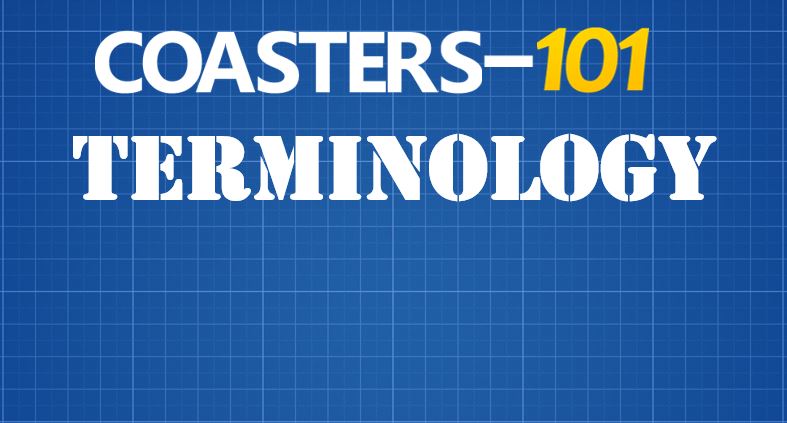
The following is a list of common physics, engineering, and other roller coaster terminology;
4th Dimension: A type of roller coaster with controlled rotatable seats cantilevered on each side of the track.
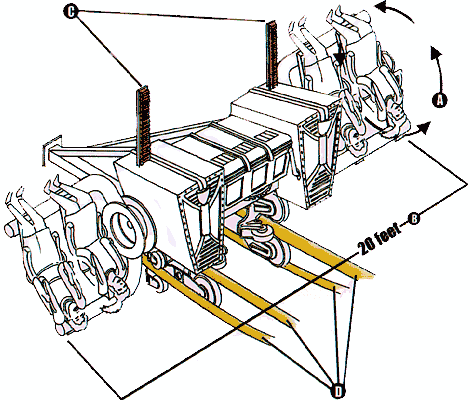
A 4th Dimension coaster
Acceleration: The rate of change of velocity with respect to time. If an object is speeding up, slowing down, or changing direction, it is accelerating (or decelerating). Acceleration describes the rate of change of both the magnitude and the direction of velocity. Acceleration = Force divided by mass (a=F/m).
Accelerometer: An electromechanical device that will measure acceleration forces.
Airtime: Roller coasters can thrust negative g’s on riders causing them to momentarily lift off their seats and become “weightless.” As the vehicle flies over the top of a hill the load on the passenger becomes less than Earth’s gravity and, in the extreme, could throw an unrestrained passenger out of the car. Scream machines with oodles of so-called “airtime” moments or “butterflies in your stomach” thrills rank among the world’s best. Negative g-forces cannot be too great because when under high negative g forces blood rushes to the head and can cause “red out.”
Block: A block is a section of a roller coaster’s track with a controllable start and stop point. Only one train may occupy a block at a time.
Bobsled: Cars travel freely down a U-shaped track (no rails) like a bobsled except on wheels.
Bunny Hops: A series of small hills engineered to give repeated doses of airtime.
Catwalk: A narrow walking ledge with handrails, often found along brake runs or lift hills to help with maintenance and evacuations.
Centrifugal Force: The force that pushes something moving in a circle towards the outside edge.
Centripetal Force: The component of force acting on a body in curvilinear motion that is directed toward the center of curvature.
Cobra roll: A half-loop followed by half a corkscrew, then another half corkscrew into another half-loop. The trains are inverted twice and exit the element the opposite direction in which they entered.
Corkscrew: A loop where the entrance and exit points have been stretched apart.
Cycle: When the train completes one circuit around the course. When trains are run continuously this is called cycling.
Cycloid: The locus of points generated by a fixed point of a circle as the circle rolls along a straight line.
Derailment: When a roller coaster train or vehicle leaves the tracks.
Dive loop: A roller coaster element where the track twists upward and to the side, similar to half a corkscrew, before diving towards the ground in a half-loop. Basically, the opposite of an Immelman inversion.
Dueling Coaster: Two separate tracks but mostly not parallel. Usually contain several head-on, near miss collision sensations.
Drive tire: Drive tires can accurately control the position of a train.
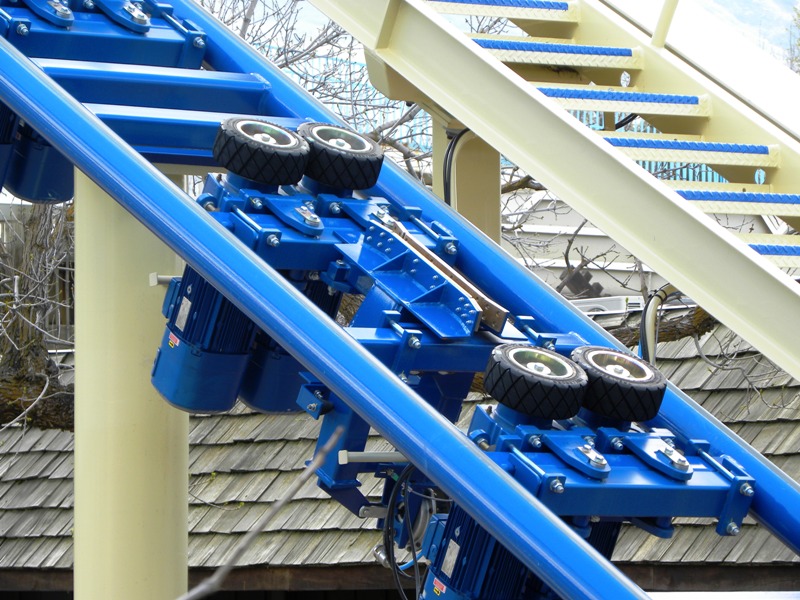
Tire driven lift. Also notice the lack of the traditional anti-roll back racks.
Dynamics: The study of the causes of, and changes in motion.
Element: A segment of coaster track that curve in a recognizable shape. Elements are often given names such as corkscrew, loop, cobra roll, dive loop, etc.
Energy: Energy is the ability of one system to do work on another system. Energy cannot be created or destroyed.
Floorless coaster: The vehicle sits above the track but contains no floor between the rider’s feet and the rails, allowing their legs to dangle freely.
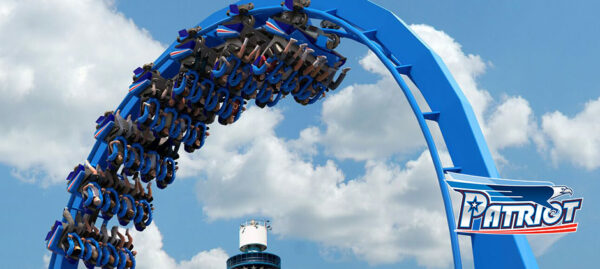
Vortex going floorless at California’s Great America
Force: An influence on an object which causes a change in velocity, direction, or shape. Force equals mass times acceleration (F=ma).
Force Vector Design: A method of roller coaster design using mathematical formulas. This system inputs a series of g-force formulas and time intervals and generates a perfect ride path based on the desired effects.
Friction: A force that resists relative motion (sliding or rolling) of an object.
Full circuit: An uninterrupted closed loop path or track.
Giga coaster: Any roller coaster with at least one element between 300 and 399 feet tall.
Gravity: The force that tends to draw objects toward the center of the Earth.
Gauge: Distance between the center of each rail on a coaster’s track. Also called the pitch.
Hill: A concave shaped element on a roller coaster’s track.
Hyper coaster: Any roller coaster with at least one element between 200 and 299 feet tall. Magnum XL-200 at Cedar Point was the first.
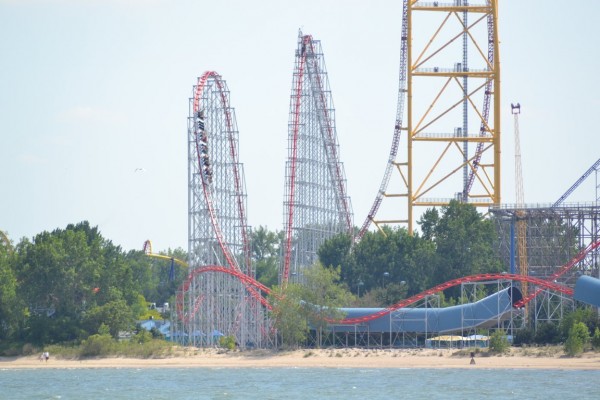
Imagineer: A person who works for Walt Disney Imagineering. This term is a combination of engineer and imagination.
Immelman: Named after the aircraft maneuver pioneered by Max Immelman, the inversion begins with a vertical loop but at the apex of the inversion turns into a corkscrew exiting at the side instead of completing the loop. The opposite of a dive loop element.
Inertia: The tendency to resist a change in motion. If an object is moving, it won’t slow down or change direction unless acted upon by an outside force, such as friction.
“An object at rest stays at rest and an object in motion stays in motion with the same speed and the in the same direction unless acted upon by an unbalanced force.”
To explain this, let’s think about an environment free of gravity, like space. If you throw a ball in space, it will theoretically fly forever in the exact direction and the exact same speed with which you threw in. However, if it met an unbalanced force such as a meteor, it would change its direction.
Inversion: An element on a roller coaster track which turns riders 180 degrees upside down and then rights them again, such as a loop, corkscrew, or barrel roll (among others). The actual degree of banking to be considered inverted is debatable, with some arguing 135 degrees is closer to upside down than not and should be considered an inversion.
Inverted coaster: Vehicle is fixed below the rails with rider’s feet hanging freely and is able to invert upside down. The terms “inverted” and “suspended” are often used interchangeably by parks.
Kinetic Energy: The energy an object possesses due to motion. Kinetic energy is one-half times the mass multiplied by velocity squared (KE=0.5*m*v*v).
Laydown/Flying coaster: Riders are parallel to the rails, either on their back or stomach.
LIM: Linear Induction Motors are a form of electro-magnetic propulsion. The stator and rotor are laid out in a line which produces a linear force (as opposed to a torque or rotation). No moving parts.
Mass: The amount of matter within an object. The terms mass and weight are often used interchangeably. However, weight = Mass * Gravity thus weight can be zero when no gravitational forces are acting upon it while mass can never equal zero.
Mobius: A racing or dueling roller coaster with one continuous track instead of two separate ones.
Momentum: Momentum is the product of the mass and velocity of an object (P=mv). The larger the mass or velocity an object, the more momentum it will have.
Motorbike coaster: Riders straddle the seats as if riding a motorcycle, jet ski, or horse.
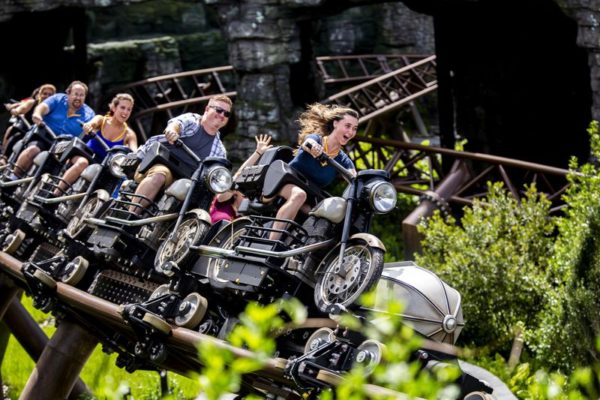
Photo © Universal Orlando Resort
Neutral slope: The amount of downgrade on a roller coaster track that will maintain an average speed of a car in motion without any change in velocity.
Normal Force: The force component perpendicular to the surface the object rests on. In most cases, the normal force (N) equals mass times gravity (N=mg) or if the object rests on an incline N=mgcos(θ) where theta is the angle to the inclined surface measured from horizontal.
Pipeline coaster: Riders are positioned between the rails instead of above or below them.
Potential Energy: The energy possessed by an object due to its position. A general equation for potential energy is mass * gravity * height (PE=mgh).
Queue: A line you stand in for an attraction, food, or entry/exit.
Racing Coaster: Two separate tracks usually parallel for most of the course. Trains are released simultaneously so they race from start to finish.
Rolling Resistance: A force resisting motion when an object rolls along a surface.
Sit down coaster: Traditional roller coaster with vehicles above the rails.
Spinning coaster: Seats can freely spin on a horizontal axis.
Standup coaster: Riders are restrained in a standing position.
Stacking: When more than one coaster train or vehicle is stopped on consecutive block brakes. Usually means the ride is not being run to maximum efficiency due to slow dispatches or other technical issues.
Statics: The equilibrium mechanics of stationary bodies.
Strain Gauge: A device used to measure the strain of an object by converting force, pressure, tension, or weight into a change in electrical resistance which can then be measured.
Swinging suspended coaster: The vehicle hangs below the rails and can freely swing from side to side but does not invert.
Tachometer: An instrument used to measure the rotation speed of a shaft
Themed/Theming: The central idea or concept for an attraction or area. Conveys the story behind an attraction to the guests.
THRC: Theoretical Hourly Ride Capacity is the number of guests per hour that can experience an attraction under optimal operating conditions. Calculated by: Riders per bench*benches per car*cars per train*(60min/ride time minutes).
Valley: A convex element on a roller coaster’s track. Also, the term used when a train or vehicle doesn’t have enough momentum to make it over the following element and becomes stuck, or “valleyed.” A valleyed vehicle needs to be evacuated and then towed over the next element.
Viscosity: The measure of how resistant to flow a liquid is.
Wing coaster: The seats are fixed on both sides of the vehicle outside of the rails. Intamin calls their lone installation a “wingrider” coaster.
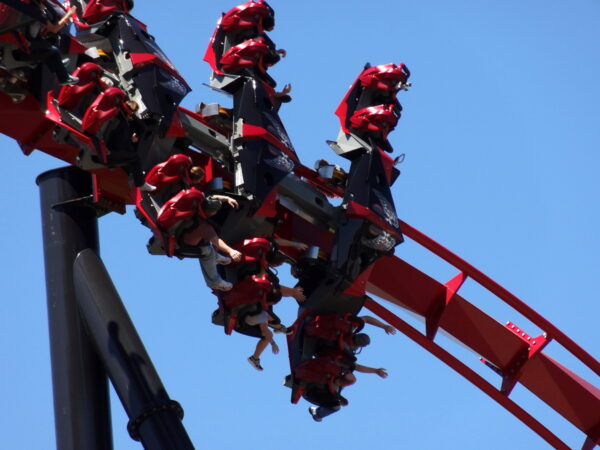
A wing coaster
Roller Coaster Terminology: Acronyms
We usually try to spell things out, but in case you’ve been reading Coaster101 articles or listening to our podcast and we drop an acronym on you that you’ve never heard, hopefully this list explains it. The following is a list of acronyms and includes common terms used throughout the amusement industry (in alphabetical order).
AC: Alternating Current
ARB: Anti-Roll Back
ACE: American Coaster Enthusiasts
ASTM: American Society of Standards and Materials
CAD: Computer Aided Design
CATIA: Computer Aided Three-Dimensional Interactive Application
CARES: Council for Amusement and Recreational Equipment Safety
CPM: Critical Path Method
DC: Direct Current
DOT: Direction of Travel
FEA: Finite Element Analysis
FMEA: Failure Mode and Effects Analysis
FTA: Fault Tree Analysis
GDT: Geometrical Dimension and Tolerance
HMI: Human Machine Interface
IAAPA: International Association of Amusement Parks and Attractions
ISO: International Organization for Standardization
LED: Light Emitting Diode
LIM: Linear Induction Motor
LOTO: Lock Out Tag Out
LSM: Linear Synchronous Motor
LPL: Large Project Leader
MBD: Model Based Definition
MTBF: Mean Time Between Failures
MTTR: Mean Time To Repair
NDA: Non-disclosure Agreement
NDT: Non-Destructive Test
OEM: Original Equipment Manufacturer
OSHA: Occupational Safety and Health Administration
OSS: Operator Safety System
PERT: Project Evaluation and Review Technique
PIC: Person-In-Charge
PL: Project Leader
PLC: Programmable Logic Controller
POV: Point of View
RA: Ride Analysis
RAC: Ride Access Control
RPM: Rotations Per Minute
SAT: Site Acceptance Test
SBNO: Standing But Not Operating
SLC: Suspended Looping Coaster
SRCS: Safety Related Control Systems
RSS: Ride Show Supervisor
T&A: Test and Adjust
THRC: Theoretical Hourly Ride Capacity
USPTO: United States Patent and Trademark Office
VFD: Variable Frequency Drive
Learn more about roller coaster design and engineering in our Coasters-101 series of article. Or if you still can’t get enough about roller coaster design, you can also check out Nick’s book here.
Did we miss any roller coaster terminology? If you have any questions please let us know in the comments below!

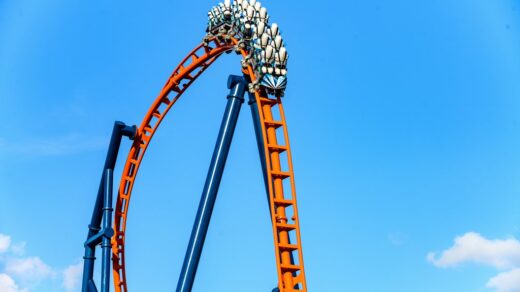
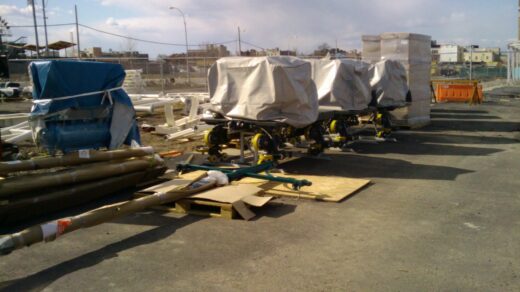
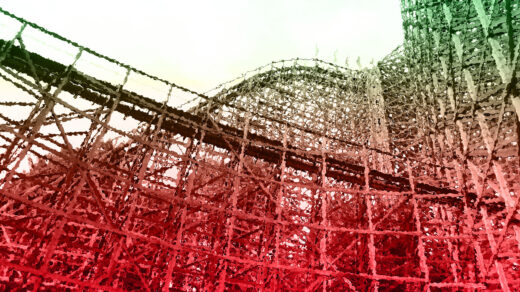





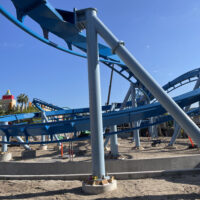





Recent Discussion